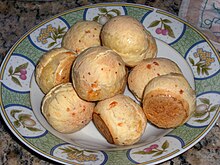Cheese bun


Cheese buns or cheese breads may refer to a variety of small, baked, cheese-flavored rolls, a popular snack and breakfast food in Brazil, Colombia, Ecuador, Argentina and Paraguay. Cheese buns may be made with cassava or corn flour, or both, and cheese. In countries where the snack is popular, it is inexpensive and often sold from street vendors, in snack shops, and in grocery stores.
Cheese buns popular in South America
- Almojábana - Throughout South America
- Chipa - Paraguay
- Chipá - Argentina
- Cuñapé - Bolivia
- Pandebono - Colombia
- Pan de queso - Colombia
- Pan de yuca - Colombia / Ecuador
- Pão de queijo - Brazil
Pão de queijo is the classic Brazilian cheese bread.
In Colombia, there is a very similar product to Brazilian cheese bread, except for its traditional format (flattened) called pan de bone or pandebono. Like the cheese bread, the pandebono has a spongy texture, low density, and which hardens in a short time, characteristics that are attributed to the sour cassava starch, know in the country as starch fermented yuca and which is obtained in the same way as in Brazil.
Paraguay and Argentine provinces in the Northeast (Formosa, Chaco, Misiones and Corrientes) also have a variation of cheese bread, called chipa or chipá, respectively. The main difference between the chipa and the cheese bread is the "U" format of the former.
In Ecuador, there is also the "pan de yuca", which is exactly equal to the Brazilian Cheese Bread, with all the same texture, shape and flavour. In Ecuador, it has become a habit to eat the "pan de yuca" accompanied by a fruit yoghurt.
Related cheese buns
- Gougère - France
